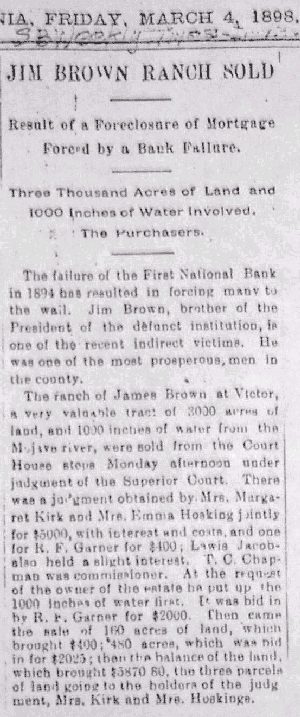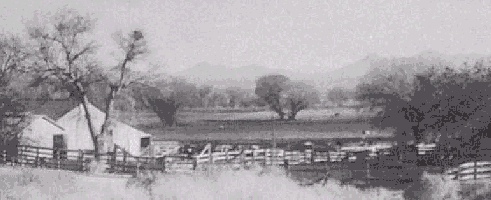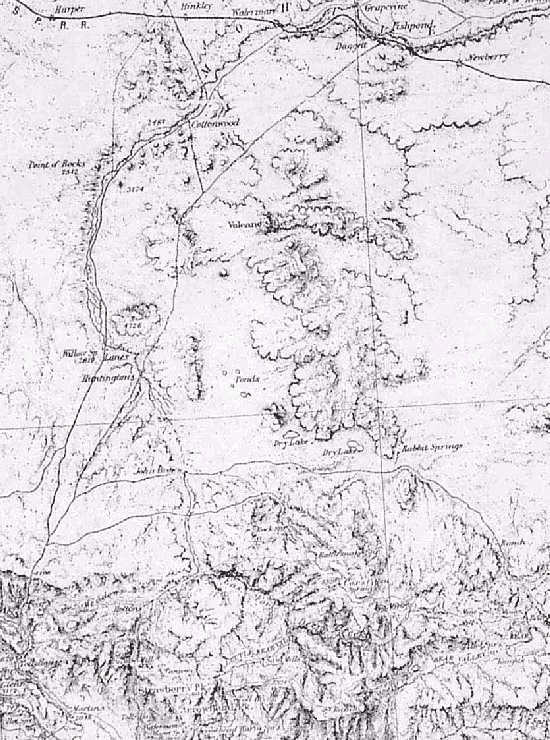

The end of the Brown ownership of the ranch is covered in some rather sad newspaper accounts. The Browns had used the property as a piggy bank for many years, mortgaging it for various ventures. It is not the purpose of this history to go into all the details, but James and Joseph and Newton's interests kept going up and down.
In the 1890s there was a severe financial recession, and many businesses throughout the nation began to fail. James tried to sell the property to a developer, as detailed in a May 8, 1896, story subtitled, "The Brown Ranch at Victor Provisionally Transferred," which appeared in the San Bernardino Times-Index:
The deeds have been placed on file by which James Brown grants to the Columbian Colonization company between 3000 and 4000 acres of land, situated in the basin about the Victor narrows, and which, according to the plans of the colonization company, is to be the site of a reservoir.... |
This was probably a desperate attempt to either raise money or salvage something from his estate. Joseph's fortunes were inextricably tied up in the First National Bank of San Bernardino, and in 1894 the bank was forced to close its doors. Two years later, a receiver began to foreclose on the bank's mortgages in order to recoup depositors' funds. These proceedings eventually reached the Brown Ranch partners and both brothers were financially ruined.
On March 4, 1898, the Weekly Times-Index announced, "Jim Brown Ranch Sold." The article was subtitled "Result of a Foreclosure of Mortgage Forced by a Bank Failure," and opened with these words:
The failure of the First National Bank in 1894 has resulted in forcing many to the wall. Jim Brown, brother of the President of the defunct institution, is one of the recent indirect victims. He was one of the most prosperous men in the county. |
The story goes on to detail how the property was auctioned off on the court house steps.

During this period the ranch is always referred to as the Brown Ranch, never as the Rancho Verde. The property, after being acquired by the mortgage holders, was then bought by John A. Cole, H. E. Harris and Milo M. Potter. On October 19, 1901, these three plus some others filed Articles of Incorporation for the Rancho Verde Company (which are located in the San Bernardino County Archives).
The main purposes of the corporation were:
To purchase, improve, hold and sell real estate, water rights and priveleges (sic), building reservoirs and ditches, laying pipes and distributing water; to buy, sell, and own horses and cattle, to operate ranches, breed horses and cattle, buy and sell grain, hay, and all kinds of farm products and do any and all things necessary to properly conduct and operate a general farming and stock ranch business. |
Prior to the incorporation of the Rancho Verde, no references to it by that name have been found.
Cole's selection of the name Rancho Verde seems to be fitting. Verde, of course, means green, and even in the hottest days of summer there is always plenty of greenery down along the river to contrast with the surrounding desert. The name and atmosphere of the place was perfect for a guest ranch, which it became for many decades.
The ranch changed hands a couple of times before Kemper and Litta Belle Campbell, with partner A. W. Sorenson, bought the property in 1924. They continued to use the Rancho Verde name, but when the Campbell's son, also named Kemper, was killed in a plane accident while training during World War II, Litta Belle changed the name to "Kemper Campbell Ranch" in his honor.
It is well known by that name today, but oldtimers, even some family members, still call it the Rancho Verde as well. Actually they call it the "North Verde," because the southern portion went to Sorenson when the original property was split in two. The south property later became the Kalin Ranch.

One last bit of explanation is necessary: why the name John Brown appears where it does on Wheeler's Atlas No 73. The map, shown once again below, was prepared by surveys done during 1871-1878, and is the map to study for students of formation of the road network in the Mojave Desert.
At the bottom left, the map shows the road coming up from San Bernardino to the Cajon Pass Summit, continuing north to Lane's. Also shown is the new road going down, southwest from Fish Pond (top right on the map), to Huntington's and on down to Cajon Pass.

SITE LOCATION SHOWN AS "JOHN BROWN" (SOUTHEAST FROM LANE'S) CAN BE SCALED FROM THE MAP, AND IS APPROXIMATELY ONE MILE SOUTH OF TODAY'S BEAR VALLEY ROAD WHERE IT CROSSES THE MOJAVE RIVER, WHICH MEANS THAT IT IS ONE MILE SOUTH OF THE MOST SOUTHERLY BOUNDARY OF THE BROWN RANCH. |
The first road to branch off to the east beyond the Cajon Summit is the Van Dusen Road. It can be seen rounding a hill, circling back up into the mountains by Rock Springs, Rattlesnake Springs, and going on into Bear Valley.
The second road to branch off to the east goes to the vicinity of Rabbit Springs and turns south up into the Cushenbury grade, and into the east end of Bear Valley. In the Apple Valley area this road is located approximately along the alignment of present-day Del Oro Road, or a mile south of Bear Valley Road.
On this road the map shows the name "John Brown" written at the crossing of the Mojave River, and the site is about one mile south of the most southerly boundary of the Brown Ranch. In the years 1874-75, Brown and his partner Kate Foulkes had a contract to carry the mail from San Bernardino to Big Bear. The mail was carried in a wagon together with freight and passengers. The crossing of the Mojave would have been a perfect place to change horses, and it is quite likely that this was a stop for just such a purpose when the second Wheeler survey was taken.
John Brown Sr. is an historic character of significant prominence: a Rocky Mountain fur trapper, an Argonaut, and one of San Bernardino's Founding Fathers. He was engaged in a high-profile project nearby, the John Brown toll road, and he seemed to be larger than life. He worked with the Indians in trying to establish a ferry across the Colorado River, he delivered the mail to Big Bear, he was Justice of the Peace, Judge of the Plains, and one of three commissioners who oversaw the creation of San Bernardino County. It is not surprising some believe he had founded one of the most famous ranches on the Mojave Desert, but in this instance, credit must go to his sons.


 PAGE
1|
2|
3|
4
PAGE
1|
2|
3|
4